![]()
![]()
![]()
![]()
![]()
![]()
![]()
![]()
![]()
![]()
![]()
When is the next
Museums and the Web?
![]()
Archives &
Museum Informatics
158 Lee Avenue
Toronto, Ontario
M4E 2P3 Canada
info@ archimuse.com
www.archimuse.com
| |
Search
A&MI |
Join
our Mailing List.
Privacy.
Copyright
Archives & Museum Informatics
2000
Outsourcing of Museums on the Web Projects in Russia
Abstract
Like museums elsewhere, Russian museums and other cultural institutions planning to create presence on the web, usually face three main problems:
1. How to get funding to create web site in the way that will ensure it would fit primary museum purposes
2. Where and how to find a team of professionals which is able to develop long-lasting project having no definiteness in the financial result
3. How to organize domestic team of professionals ready to participate in the project development in the way, which would benefit to the museum in terms of advertising, promotion, fundraising, commercial results, organizational issues, etc.
All these problems are analyzed in this paper as well as the sources of funding of Russian cultural heritage projects on the web.
Introduction
Museums like all cultural institutions have three basic objectives of their presence in Internet:
- Providing access to cultural heritage (connecting museum with society)
- Promotion of culture in society (connecting cultural/educational information with society)
- Applying of Information Technologies for preservation of cultural heritage (connecting technologies with museum).
But do these three objectives meet real position of museums in the society? In particular, Russian museums have been developing their information policy focused basically on the third objective. However in post-Soviet time the position of museums in society has changed significantly, and state budget support was considerably cut. We faced problems, which US museums had faced in 70-ies. In these circumstance the importance of two first objectives - providing access to cultural heritage and promotion of culture in society - dramatically increased. In order to survive our museums were to rethink their mission and position in society and make every effort to appear as a significant element of overall economic structure.
Penetration of the Internet appeared to become a powerful tool uniting all the three objectives. The role of Internet in Russia grows dramatically and in at least two cities (Moscow and St.-Petersburg), it will become one of the main media channels along with mass media (TV, radio, the press). The interdisciplinary character of the problem of integration of the three objectives required new approaches and new people in a museum staff - specialists in marketing, PR, fundraising, and even system administrators. Here museums faced the situation when they havenít had appropriate staff members or even the opportunity to hire them. These specialists were concentrated in a sphere of newborn Russian business. Thus museums realized a need to form partnerships with new businesses- private companies in Russia and abroad.
From the Museum to Internet through Outsourcing
Now, outsourcing of museums on the web projects
in the USA and Europe is often focused on technological issues, as these
great museums have professional staff able to set and solve the tasks
of fundraising, management, web development, and promotion. On the contrary,
most of museum web projects in our country are carried out by private
companies and thus the role of outsourcing of these projects is very important.
Russian museums wishing to reap the benefits afforded by digital technologies
and planning to create a presence on the web, usually face three main
problems:
1. How to get funding to create a web site in the way that will ensure
it would fit primary museum purposes
2. How to find a team of professionals, which are able to develop long-lasting
projects having no definiteness in the financial result
3. How to organize a domestic team of professionals ready to participate
in the project development which would benefit to the museum through advertising,
promotion, fundraising, commercial results, organizational issues, etc.
The criteria of selecting of commercial partners
to develop museum projects on the web are as follows:
1. The partner's portfolio in the field. Great attention while estimating
the potential partner is paid to content issues, in particular styles
of the texts, data management, copyright issues.
2. To what extent does the potential partner understand specific museum
problems? From the museum mission and up to and including the collections
management issues.
3. To what extent is the potential partner ready to conduct a mutual dialogue
with cultural institutions in terms of strategic planning of web site
presence: from concept and writing, to web site maintenance and updating
On the other hand, there are some basics of efficient participation of the museum's representatives in the project implementation:
1. Locating museum staff members who would be able to participate in the
project according to the following criteria:
- experience in content building in the field of the museum profile, research or education background is highly recommended
- knowledge of opportunities IT provide (special education is not required, though is highly recommended)
- knowledge of management issues
- ability to merge creative content with creative technologies and set reasonable tasks
- knowledge of foreign languages
- ability to lear
2. Training of the staff in the field of technology and project management
3.Recruiting the museum staff members to design content and participate in project
development within the project team, managed by the private company.
Professional education in the field is still random. Although there does exists several public and professional organizations able to provide this sort of assistance - Russian Department of ICOM, and ADIT - Association of Documentation and New Information Technologies. Nevertheless all practical issues associated with web project development and management lead to the development of companies with a special profile. These could unite most advanced museum staff members with professional IT specialists. One of these companies is CTOR_STUDIO LANCK (St.-Petersburg).
There are six types of museum projects on the web that strongly require theses complex services:
- Museum educational sites
- Museum community based sites, intended to transform the Museum website into a news item
- Cultural tourism oriented sites
- Composite sites fulfilling several tasks - attracting tourists, education, and entertainment
- Museum collections presentation and data management
- Sites oriented to promote museum e-commerce on the net and provide services.
Stages of Outsourcing of Museum of the Web Projects
Stage 1. Consulting
1.1 Generating reasonable motivation of the museum to create a web site. Here we have to oppose, or to be more precise, to supplement and develop statements like "We would like to be the best on the web" (typical argument of great and well-known museums), or "We would like people to see we are professional" (typical argument of a provincial museum).
1.2 Looking for sources of financing. There are several sources of funding of Russian cultural heritage projects on the web. Their sequence is in terms of accessibility to Russian cultural institutions :
- Local commercial companies
- Local bodies
- Western foundations having their representatives in Russia
- Western foundations having no their representatives
in Russia
Russian cultural foundations - Federal bodies (the Ministry of Culture, etc.)
|
Source of financing |
Share |
|
Museum |
5% |
|
Foundation (foreign and national) |
40% |
|
Local bodies |
20% |
|
Sponsorship of local private companies |
10% |
|
Patrons of art |
10% |
|
Other sources |
15% |
Typical scheme of financing of museums on the web projects in Russia
1.3. Complex analysis of the museum information environment and potential and locating the field, which should be re-created on the web to benefit the museum mission, attendance, educational programs, etc.
1.4. Revealing and examining of target audience/visitor studies.
1.5. Choosing of appropriate technical solutions of information presentation.
1.6. Networking of the project.
Stage 2. Infrastructure of the project
2.1. Assembling the project museum team
2.1. Learning and training of the museum team, and in many cases - of IT specialists of private companies
2.3. Working out the concept of the project.
Stage 3. Project implementation, promotion, hosting, and maintenance.
A private company in constant coordination with the museum team carries out all implementation issues. All media planning issues are also subjects of outsourcing.
Stage 4. Copyright issues.
Building a strategy for protecting images and other museum information. In most cases, studies in the field are committed, as state regulation of these issues are still being generated.
Distinctive Features of Outsourcing of Different Types of Museum on the Web Projects
Though the mentioned stages are very important in any type of project, there exist some distinctive features, which make some issues especially important. Let us analyze some cases.
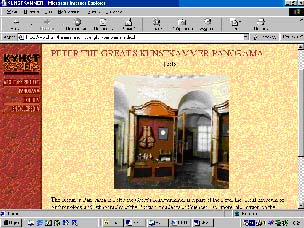
Museum educational site (the site of Peter the Great Museum of Anthropology and Ethnography (Kunstkammer) of the Russian Academy of Sciences http://www.kunstkamera.lanck.ru). Fig.1.
The accent was made on the content issues of the project and the style of information presentation. Specialists of the private company were to acquire specific museum information and work in close cooperation with museum team on the stage of complex analyzing of the museum information environment, visitor studies, networking of the project, and building infrastructure of the project. Great attention was paid to the form of information presentation - surround video panorama, dynamic images in Quick Time 4.0 (stages 1,2;1,3;1,4;1,5;1,6;2,1 were of particular importance).
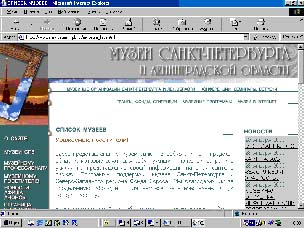
Museum community based site (the site "Museums of St.-Petersburg and the Leningrad Region" http://www.allmuseums.spb.ru). Fig. 2.
Here the central point was executing and managing of a complete news and information system, including article generation, features, newsletters, guest writers, columnists, etc. The resources available included CGI system and website, email and listserver, and html delivery mechanisms.
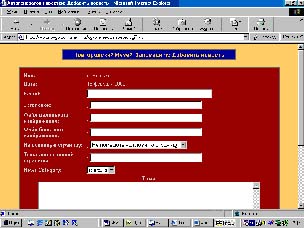
Prototype of updating software, Fig. 3
Special prototype software "WebNewsline" (fig.3) of CTOR_STUDIO LANCK has been designed for on-line up dating of news and images from remote computers. It is being used now by 24 museums of St.-Petersburg, where museum staff members, standard computer users, update information on the site almost every day. The St.-Petersburg newspaper "Vse muzei" (All Museums) is placed on the web also with the help of this feature. Project implementation, promotion, and maintenance were the items of outsourcing (stages 1,5;3 were of particular importance).
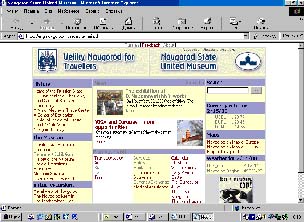
Cultural tourism oriented site (the site of Novgorod State Museum "Veliky Novgorod for Travellers. Novgorod State United Museum" http://www.novgorod-museum.ru). Fig. 4.
Here main task of outsourcing was to build the site into the context of local territory in order to attract tourists and visitors, to reveal its cultural potential, to demonstrate quality of services offered, transport and communication accessibility, etc. Knowledge of the target audience was a key point of success; therefore CTOR_STUDIO LANCK invited in a leading project team of museum sociologists of St.-Petersburg. The Bureau of Educational and Cultural Affairs at the United States provided funding for this web site with development assistance from the Colonial Williamsburg Foundation. It was a challenging experience for the team, as we were to create the web site promoting Veliky Novgorod as a cultural treasure for potential American tourists. 85% of work was implemented by the studio, and 15% - by the Museum (stages 1,3 were of particular importance).
4.Composite sites unite several tasks, such as attracting tourists, education, and entertainment. The site of Tzarskoje Selo http://www.tzar.ru ) is an example of this, shown in Fig.5.
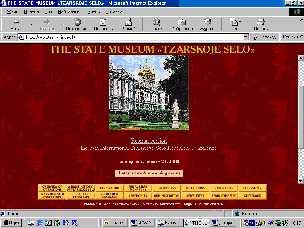
Example of the site of Tzarskoje Selo http://www.tzar.ru ) Fig.5.
The complex of tasks of this site are concentrated around the well-known mystery of the Amber Room. Excellent visual presentation of the dynamics of the work to reconstruct the Amber Room is given. The entire process of the Amber Room reconstruction is fixed in phases (fig. 6) as well in variants of matching of amber mosaics in the process of reconstruction and will be used in the near future as a prototype of the game - jigsaw puzzle, "Assemble the Amber Room Yourself". The studioís basic task here is to choose appropriate software and provide high quality hosting and fast access to the feature (stages 1,3,4 are of particular importance).
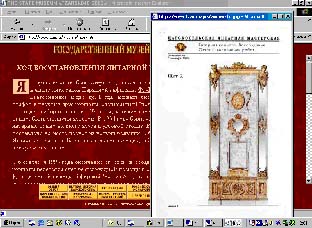
The Amber Room of the Tzarskoje Selo, Fig. 6.
5. Museum collection presentation and data management sites. We now start a project with St.-Petersburg Archive of Film-Photo Documents to make a web database of their photo documents and we are in the process of compiling a business plan. According to our preliminary estimation the archive itself will be able to carry out no more than 10% of work of the project. Additional information will be available shortly.
6. Sites oriented to promote museum e-commerce on the net (for example current project of the consortium of 5 St.-Petersburg museums got together in order to create Russian the museum store on the net analogous to museumshop.com). We have a written business plan of the project and have revealed the particular importance of stage 4. This project is a sort of pilot project for Russian museums.
Current and Forthcoming Tasks of Outsourcing
Today, the process of creating of museum databases in Russia is very uneven. The most advanced solutions and technologies were applied by the Hermitage Museum together with IBM - more than 1000 objects have been digitized and many of them are available on-line. Other museums are on very different levels of understanding and development of the process. It is obvious that in the near future central attention will be concentrated around the problems of meta data, data management, and information policy development of the Russian Cultural Heritage Network, being designed by the Ministry of Culture together with the "Open Society Institute" of George Soros Foundation, and ADIT.
The project is on its very first stage and the current state of Russian museum collection management system makes us think this process will last for several years. In this situation, one of the tasks of outsourcing will be analyzing of western experience and the gradual integration of Russian museums.
The chart below shows the positions of partners - main outsourcing bodies in Russia - in the development of museums on the web projects in Russia in comparison with its preferable position. Both the position and influence of these bodies are too strong and have to take place in museums, which currently are poorly protected from both commercial and copyright risks. Russian museums need more interaction with direct financing bodies, either state resources or national/ foreign foundations.
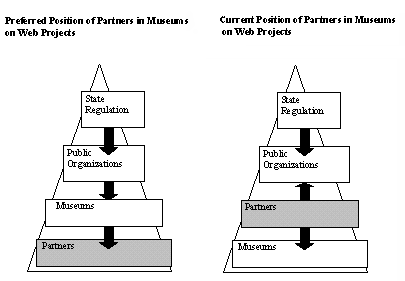
Projects on the Web Projects in Russia
In course of 3 years experience of mutual work with 32 museums of St.-Petersburg and the region CTOR_STUDIO LANCK has implemented the following range of services:
- All-round analysis on the information potential of cultural institution
- Working out strategy and tactics of a museum on the web
- Web site development applying most advanced technology solutions (flash, Quick Time, real audio, mp3, on-line updating technologies, RDBMS, multimedia application, etc.)
- Web site promotion, maintenance, and hosting
- Development of virtual exhibitions to support real museum exhibitions within Russia and abroad
- Creating and maintenance of virtual communities, including friends' of museums, visitors', amateurs', patrons', etc.
- Consulting in the field of integration and cooperation with international museum information systems, information support of the process
- Strategic and technological solutions to provide integration of museum local information structure with Internet
- Testing and redesign of museum information production.

